Threat and Risk Analysis-Based Neural Network for a Chemical Explosion (TRANCE) Model to Predict Hazards in Petroleum Refinery
Abstract
1. Introduction
2. Materials and Methods
TRANCE Topology
3. Process Description
4. Results and Discussions
4.1. Flammable Area of Vapour Cloud
4.2. Jet Fire from Thermal Radiation
4.3. Fireball Thermal Radiation
4.4. Blast Force from Vapor Cloud Explosion
4.5. Performance of the TRANCE Model
4.6. Limitations of the TRANCE Model
5. Conclusions
Author Contributions
Funding
Institutional Review Board Statement
Informed Consent Statement
Data Availability Statement
Acknowledgments
Conflicts of Interest
References
- Saloua, B.; Mounira, R.; Salah, M.M. Fire and Explosion Risks in Petrochemical Plant: Assessment, Modeling and Consequences Analysis. J. Fail. Anal. Prev. 2019, 19, 903–916. [Google Scholar] [CrossRef]
- Tauseef, S.M.; Abbasi, T.; Pompapathi, V.; Abbasi, S.A. Case Studies of 28 Major Accidents of Fires/Explosions in Storage Tank Farms in the Backdrop of Available Codes/Standards/Models for Safely Configuring Such Tank Farms. Process Saf. Environ. Prot. 2018, 120, 331–338. [Google Scholar] [CrossRef]
- Jayakumar, C.; Isac, S.; Prasad, D.M.R. Emergency Response Plan for Methane and Chlorine with Dispersion Modelling Using CAMEO. Int. J. Occup. Saf. Ergon. 2021, 28, 1802–1810. [Google Scholar] [CrossRef] [PubMed]
- Samia, C.; Hamzi, R.; Chebila, M. Contribution of the Lessons Learned from Oil Refining Accidents to the Industrial Risks Assessment. Manag. Environ. Qual. Int. J. 2018, 29, 643–665. [Google Scholar] [CrossRef]
- Freeman, R.A. CCPS Guidelines for Chemical Process Quantitative Risk Analysis. Plant/Oper. Prog. 1990, 9, 231–235. [Google Scholar] [CrossRef]
- Chettouh, S.; Hamzi, R.; Benaroua, K. Examination of Fire and Related Accidents in Skikda Oil Refinery for the Period 2002–2013. J. Loss Prev. Process Ind. 2016, 41, 186–193. [Google Scholar] [CrossRef]
- Dobashi, R. Fire and Explosion Disasters Occurred Due to the Great East Japan Earthquake (11 March 2011). J. Loss Prev. Process Ind. 2014, 31, 121–126. [Google Scholar] [CrossRef]
- Fahim, M.A.; Alsahhaf, T.A.; Elkilani, A. Safety in Petroleum Refineries. In Fundamentals of Petroleum Refining; Elsevier: Amsterdam, The Netherlands, 2010; pp. 357–376. [Google Scholar] [CrossRef]
- Bi, H.; Xie, X.; Wang, K.; Cao, Y.; Shao, H. A Risk Assessment Methodology of Aluminum Dust Explosion for Polishing Process Based on Laboratory Tests. Proc. Inst. Mech. Eng. O J. Risk Reliab. 2021, 235, 627–636. [Google Scholar] [CrossRef]
- Timbang, A.; Reddy Prasad, D.M.; Bin Azri, M.H.; Sofri, S. Addressing Process Safety Challenges in Downstream Industries in Brunei Darussalam. Int. J. Occup. Saf. Ergon. 2021, 28, 2284–2292. [Google Scholar] [CrossRef]
- Sofri, S.; Reddy Prasad, D.M.; Bin Azri, M.H.; Timbang, A. Analysis of Chemical Engineering Curriculum to Improve Process Safety Competency. Int. J. Occup. Saf. Ergon. 2022, 29, 642–650. [Google Scholar] [CrossRef]
- Gupta, K. Design of District Emergency Operations Centres, and the Case Study of Indian Oil Corporation Jaipur Depot Explosion. Int. J. Emerg. Manag. 2010, 7, 221–232. [Google Scholar] [CrossRef]
- Editors, G.; Jaromír Klemeš, J.; Yen Liew, P.; Shin Ho, W.; Shiun Lim, J.; Tarmimi Abu Bakar, H.; Han Siong, P.; Koy Yan, C.; Kidam, K.; Wijayanuddin Ali, M.; et al. Analysis of Main Accident Contributor according to Process Safety Management Elements Failure. Chem. Eng. Trans. 2017, 56, 991–996. [Google Scholar] [CrossRef]
- Sesseng, C.; Storesund, K.; Steen-Hansen, A. Analysis of 985 Fire Incidents Related to Oil-and Gas Production on the Norwegian Continental Shelf. In Safety and Reliability—Safe Societies in a Changing World, Proceedings of the 28th International European Safety and Reliability Conference—ESREL 2018, Trondheim, Norway, 17–21 June 2018; Taylor & Francis Group: London, UK, 2018; pp. 1847–1854. [Google Scholar] [CrossRef]
- Kriaa, S.; Bouissou, M.; Laarouchi, Y. A New Safety and Security Risk Analysis Framework for Industrial Control Systems. Proc. Inst. Mech. Eng. O J. Risk Reliab. 2019, 233, 151–174. [Google Scholar] [CrossRef]
- Tang, Y.; Jing, J.; Zhang, Z.; Yang, Y. A Quantitative Risk Analysis Method for the High Hazard Mechanical System in Petroleum and Petrochemical Industry. Energies 2017, 11, 14. [Google Scholar] [CrossRef]
- Yoon, H.; Park, J.; Lim, W.; Lee, K.; Choi, N.; Lee, C.; Moon, I. Integration of Qualitative and Quantitative Risk Assessment Methods for Gas Refinery Plants. Korean J. Chem. Eng. 2013, 30, 1368–1374. [Google Scholar] [CrossRef]
- Iskender, H. Risk Assessment for an Acetone Storage Tank in a Chemical Plant in Istanbul, Turkey: Simulation of Dangerous Scenarios. Process Saf. Prog. 2021, 40, 234–239. [Google Scholar] [CrossRef]
- Terzioglu, L.; Iskender, H. Modeling the Consequences of Gas Leakage and Explosion Fire in Liquefied Petroleum Gas Storage Tank in Istanbul Technical University, Maslak Campus. Process Saf. Prog. 2021, 40, 319–326. [Google Scholar] [CrossRef]
- Lobato, J.; Rodríguez, J.F.; Jiménez, C.; Llanos, J.; Nieto-Márquez, A.; Inarejos, A.M. Consequence Analysis of an Explosion by Simple Models: Texas Refinery Gasoline Explosion Case. Afinidad J. Chem. Eng. Theor. Appl. Chem. 2009, 66, 543. [Google Scholar] [CrossRef]
- Movahed, A.; Jahani, F.; Parvini, M.; Shakib, M. Consequence Analysis of Gas Condensate Leakage in a Gas Refinery to Develop an Emergency Response Plan. J. Occup. Hyg. Eng. Vol. 2019, 6, 1–8. [Google Scholar]
- Atkinson, G.; Cowpe, E.; Halliday, J.; Painter, D. A Review of Very Large Vapour Cloud Explosions: Cloud Formation and Explosion Severity. J. Loss Prev. Process Ind. 2017, 48, 367–375. [Google Scholar] [CrossRef]
- Choi, Y.; Bhadriaju, B.; Cho, H.; Lim, J.; Han, I.S.; Moon, I.; Kwon, J.S.I.; Kim, J. Data-Driven Modeling of Multimode Chemical Process: Validation with a Real-World Distillation Column. Chem. Eng. J. 2023, 457, 141025. [Google Scholar] [CrossRef]
- Alamri, A.H. Application of Machine Learning to Stress Corrosion Cracking Risk Assessment. Egypt. J. Pet. 2022, 31, 11–21. [Google Scholar] [CrossRef]
- Harirchian, E.; Aghakouchaki Hosseini, S.E.; Jadhav, K.; Kumari, V.; Rasulzade, S.; Işık, E.; Wasif, M.; Lahmer, T. A Review on Application of Soft Computing Techniques for the Rapid Visual Safety Evaluation and Damage Classification of Existing Buildings. J. Build. Eng. 2021, 43, 102536. [Google Scholar] [CrossRef]
- Kumari, P.; Wang, Q.; Khan, F.; Kwon, J.S.I. A Unified Causation Prediction Model for Aboveground Onshore Oil and Refined Product Pipeline Incidents Using Artificial Neural Network. Chem. Eng. Res. Des. 2022, 187, 529–540. [Google Scholar] [CrossRef]
- Samanipour, S.; Kaserzon, S.; Vijayasarathy, S.; Jiang, H.; Choi, P.; Reid, M.J.; Mueller, J.F.; Thomas, K.V. Machine Learning Combined with Non-Targeted LC-HRMS Analysis for a Risk Warning System of Chemical Hazards in Drinking Water: A Proof of Concept. Talanta 2019, 195, 426–432. [Google Scholar] [CrossRef]
- Elshaboury, N.; Al-Sakkaf, A.; Alfalah, G.; Abdelkader, E.M. Data-Driven Models for Forecasting Failure Modes in Oil and Gas Pipes. Processes 2022, 10, 400. [Google Scholar] [CrossRef]
- Zakikhani, K.; Nasiri, F.; Zayed, T. A Review of Failure Prediction Models for Oil and Gas Pipelines. J. Pipeline Syst. Eng. Pract. 2020, 11, 03119001. [Google Scholar] [CrossRef]
- Kumari, P.; Halim, S.Z.; Kwon, J.S.I.; Quddus, N. An Integrated Risk Prediction Model for Corrosion-Induced Pipeline Incidents Using Artificial Neural Network and Bayesian Analysis. Process Saf. Environ. Prot. 2022, 167, 34–44. [Google Scholar] [CrossRef]
- Bhadriraju, B.; Kwon, J.S.I.; Khan, F. OASIS-P: Operable Adaptive Sparse Identification of Systems for Fault Prognosis of Chemical Processes. J. Process Control 2021, 107, 114–126. [Google Scholar] [CrossRef]
- Kim, K.; Lim, S.; Lee, C.H.; Lee, W.J.; Jeon, H.; Jung, J.; Jung, D. Forecasting Liquefied Natural Gas Bunker Prices Using Artificial Neural Network for Procurement Management. J. Mar. Sci. Eng. 2022, 10, 1814. [Google Scholar] [CrossRef]
- Gollangi, R.; Nagamalleswara Rao, K. Energetic, Exergetic Analysis and Machine Learning of Methane Chlorination Process for Methyl Chloride Production. Energy Environ. 2022, 0958305X221109604. [Google Scholar] [CrossRef]
- Jiang, P.; Craig, P.; Crosky, A.; Maghrebi, M.; Canbulat, I.; Saydam, S. Risk Assessment of Failure of Rock Bolts in Underground Coal Mines Using Support Vector Machines. Appl. Stoch. Models Bus. Ind. 2018, 34, 293–304. [Google Scholar] [CrossRef]
- Ossai, C.I. A Data-Driven Machine Learning Approach for Corrosion Risk Assessment—A Comparative Study. Big Data Cogn. Comput. 2019, 3, 28. [Google Scholar] [CrossRef]
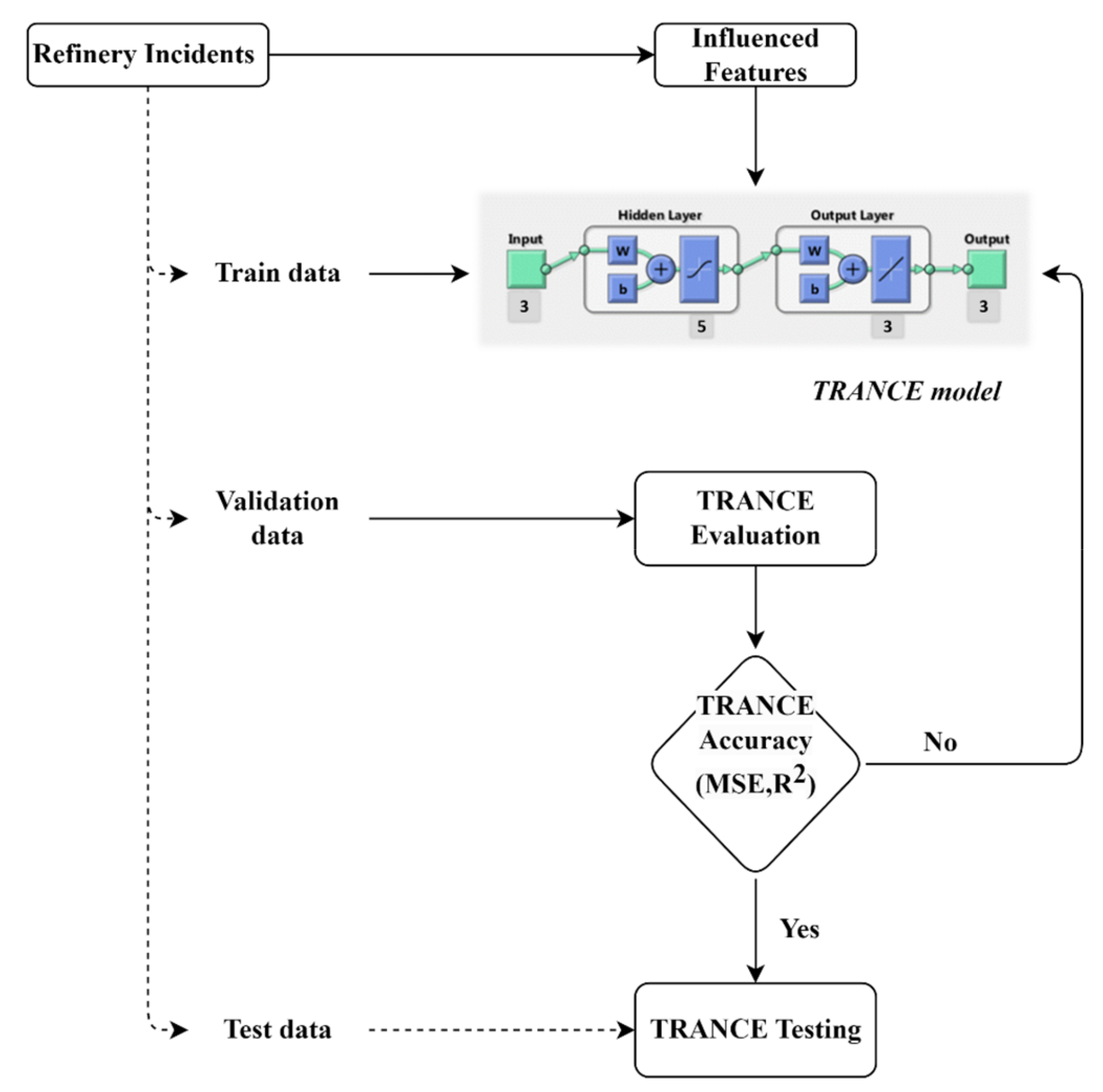
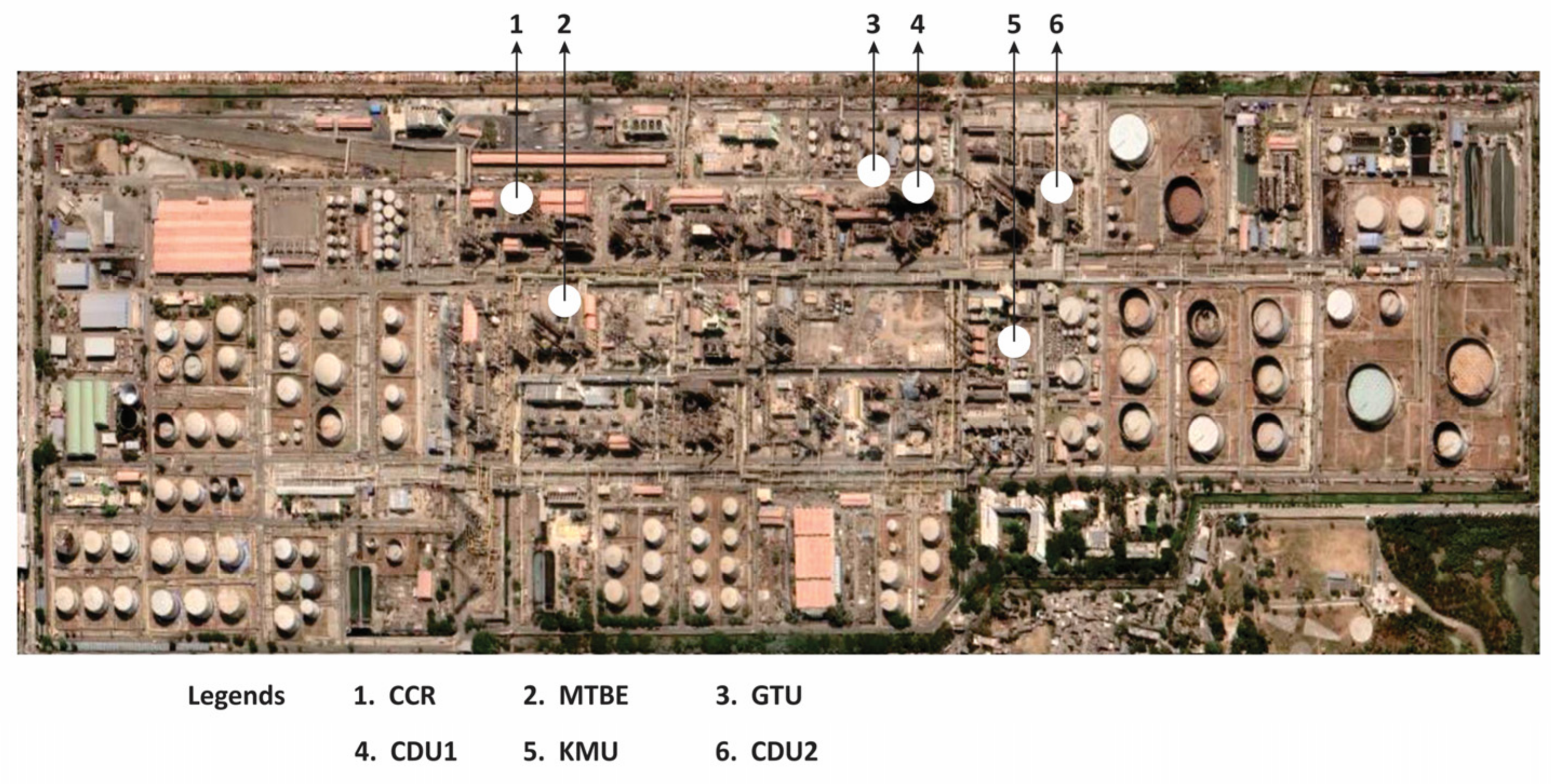

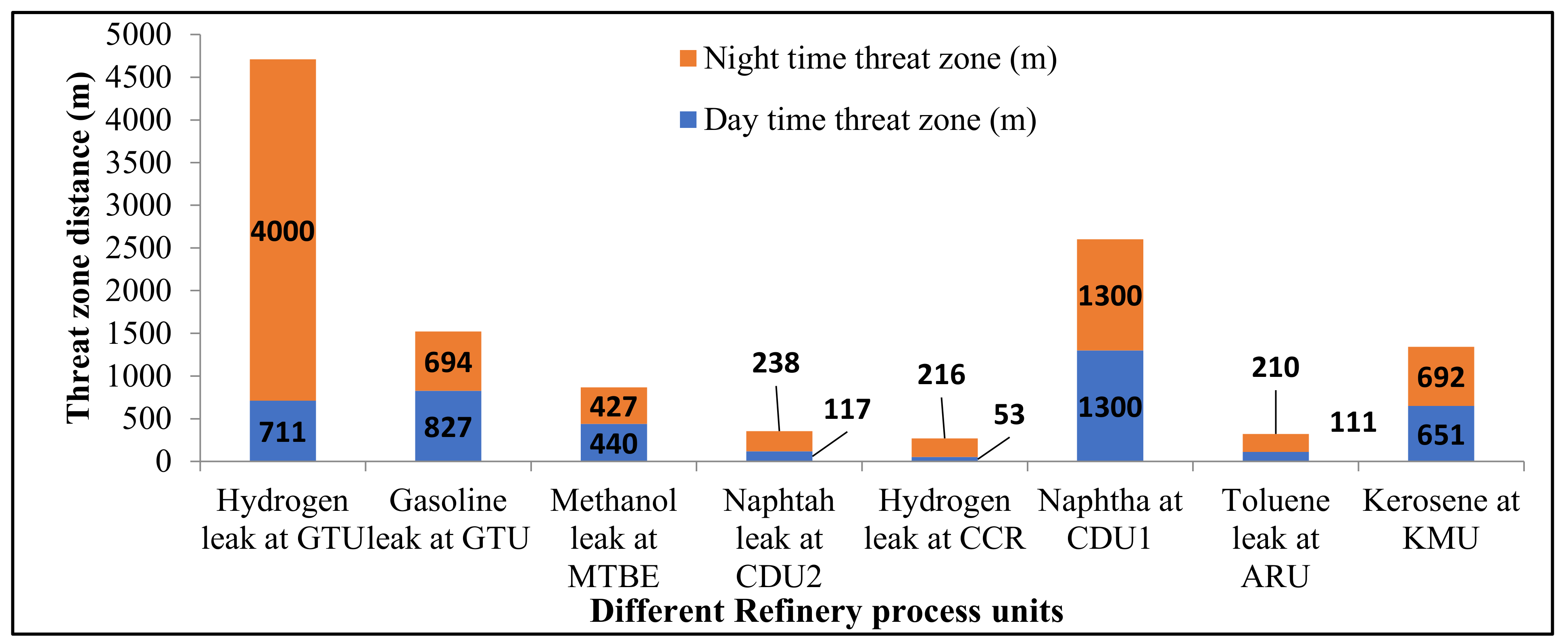


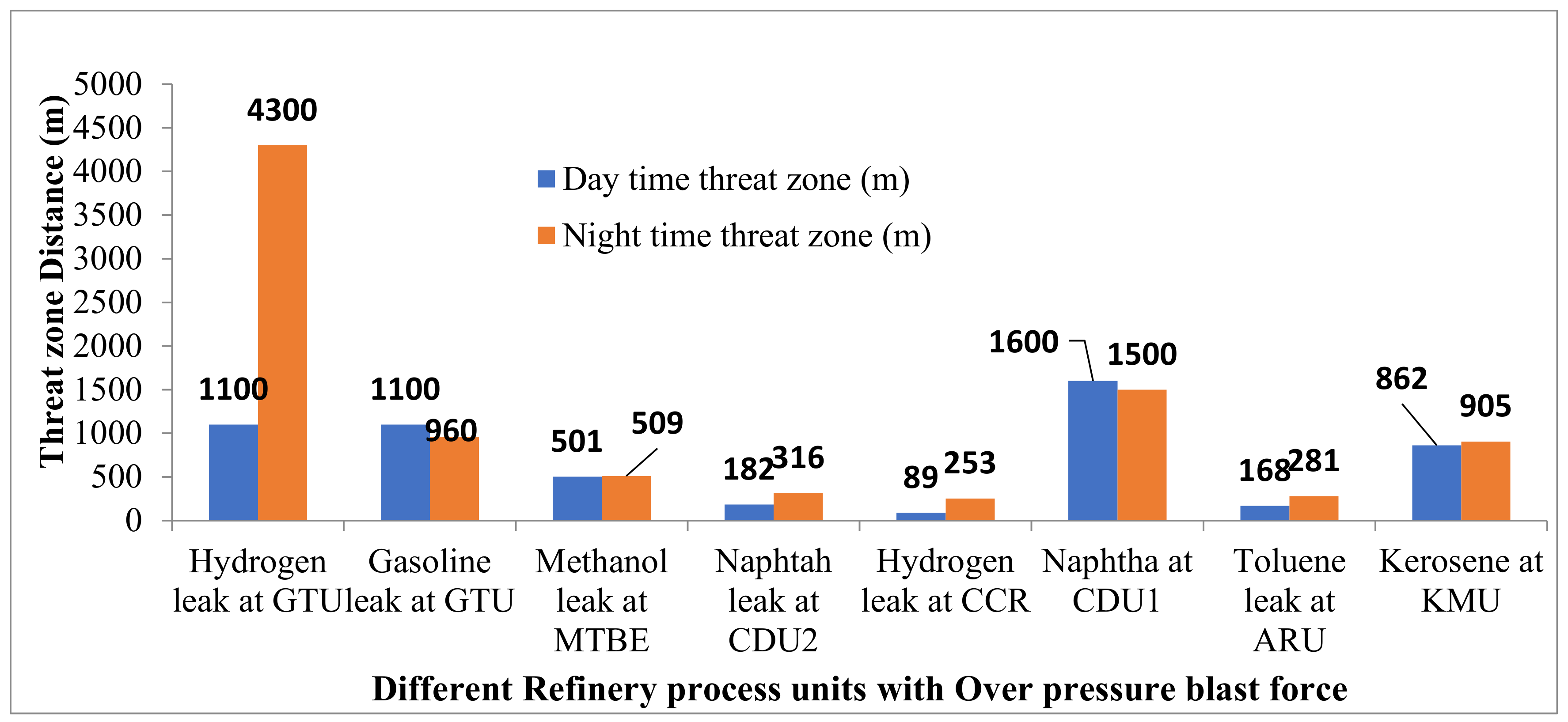
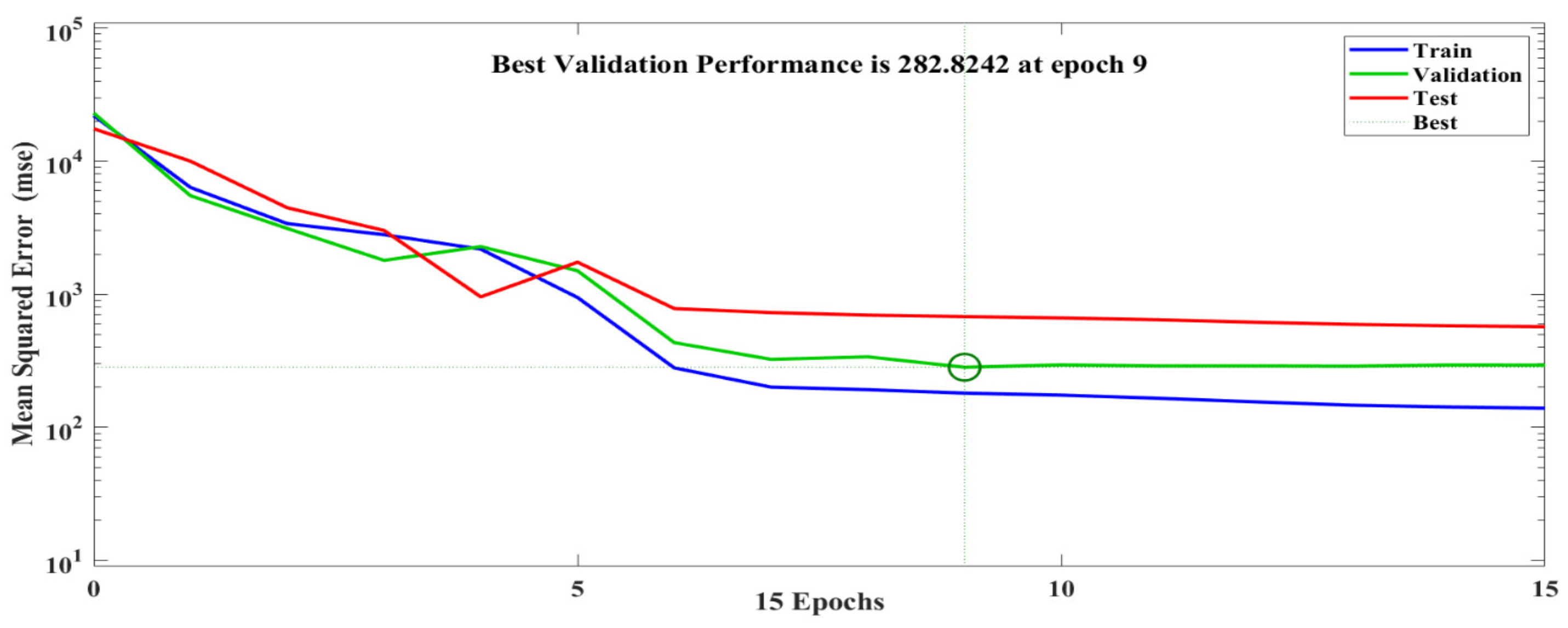
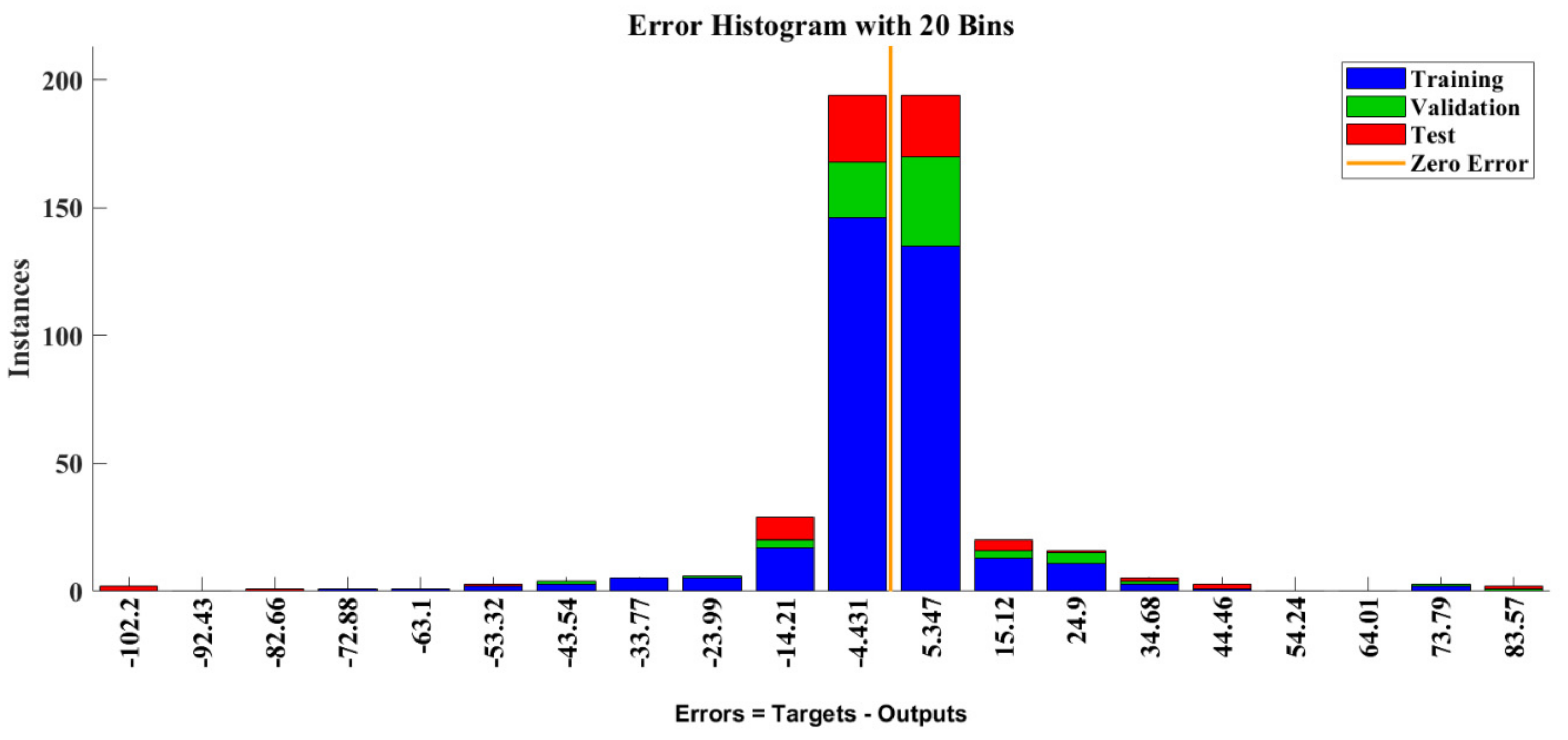
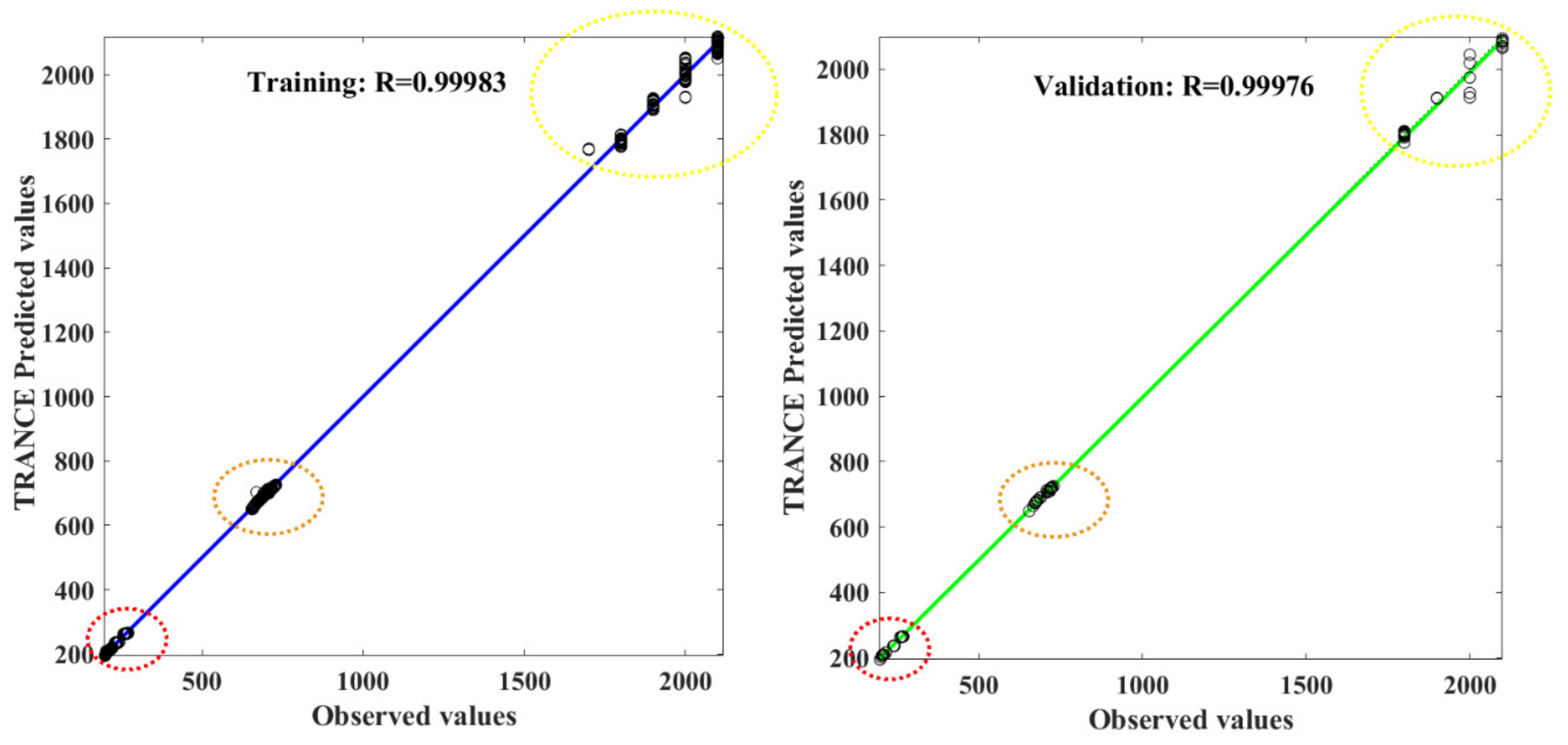

| SNo. | Plant Location | Weather Condition | Situation | Leak Size | Pipe Dia | Pipe Length |
|---|---|---|---|---|---|---|
| 1 | GTU | 5D | Catastrophic rupture of hydrogen pipeline in the summer daytime | FBR | 300 mm | 160 m |
| 2 | GTU | 1.5F | Catastrophic rupture of hydrogen pipeline in the winter night-time | FBR | 300 mm | 160 m |
| 3 | CCR | 5D | The leak of hydrogen pipeline in the summer daytime | 150 mm | 450 mm | 137 m |
| 4 | CCR s | 1.5 F | The leak of hydrogen pipeline in the winter night-time | 150 mm | 450 mm | 137 m |
| 5 | GTU | 5 D | The leak of gasoline pipeline in the summer daytime | 150 mm | 450 mm | 250 m |
| 6 | GTU | 1.5 F | The leak of gasoline pipeline in the winter night-time | 150 mm | 150 mm | 250 m |
| 7 | KMU | 5 D | Catastrophic rupture of kerosene pipeline in the summer daytime | FBR | 450 mm | 10 m |
| 8 | KMU | 1.5 F | Catastrophic rupture of kerosene pipeline in the winter night-time | FBR | 450 mm | 10 m |
| 9 | MTBE | 5 D | The leak of methanol pipeline in the summer daytime | 150 mm | 150 mm | 30 m |
| 10 | MTBE | 1.5 F | The leak of methanol pipeline in the winter night-time | 150 mm | 150 mm | 30 m |
| 11 | CDU1 | 5 D | The leak of crude pipeline (IS2) in the summer daytime | FBR | 450 mm | 800 m |
| 12 | CDU1 | 1.5 F | The leak of crude pipeline (IS2) in the winter night-time | FBR | 450 mm | 800 m |
| 13 | CDU2 | 5D | The leak of naphtha pipeline (IS2) in the summer daytime | FBR | 450 mm | 30 m |
| 14 | CDU2 | 1.5F | The leak of naphtha pipeline (IS2) in the winter night-time | FBR | 450 mm | 30 m |
| 15 | ARU | 5 D | The leak of toluene in the summer daytime | 150 mm | 150 mm | 10 m |
| 16 | ARU | 1.5 F | The leak of toluene in the winter night-time | 150 mm | 150 mm | 10 m |
| Particulars | Specifications |
|---|---|
| Number of neurons in first and second hidden layer | 5, 3 |
| Number of features in input and output | 3, 3 |
| Training algorithm | Feed-forward back propagation |
| Optimization algorithm | Trainlm (Levenberg-Marquardt) |
| Activation function | Sigmoid and Linear |
| Performance-evaluation function | MSE, R2 |
| Minimum number of epochs | 15 |
| Number of scenarios considered for risk assessment | 163 |
| Observations | MSE | R2 | |
|---|---|---|---|
| Training | 113 | 180.7024 | 0.9998 |
| Validation | 24 | 282.8242 | 0.9998 |
| Testing | 24 | 679.5343 | 0.9994 |
Disclaimer/Publisher’s Note: The statements, opinions and data contained in all publications are solely those of the individual author(s) and contributor(s) and not of MDPI and/or the editor(s). MDPI and/or the editor(s) disclaim responsibility for any injury to people or property resulting from any ideas, methods, instructions or products referred to in the content. |
© 2023 by the authors. Licensee MDPI, Basel, Switzerland. This article is an open access article distributed under the terms and conditions of the Creative Commons Attribution (CC BY) license (https://creativecommons.org/licenses/by/4.0/).
Share and Cite
Gabhane, L.R.; Kanidarapu, N. Threat and Risk Analysis-Based Neural Network for a Chemical Explosion (TRANCE) Model to Predict Hazards in Petroleum Refinery. Toxics 2023, 11, 350. https://doi.org/10.3390/toxics11040350
Gabhane LR, Kanidarapu N. Threat and Risk Analysis-Based Neural Network for a Chemical Explosion (TRANCE) Model to Predict Hazards in Petroleum Refinery. Toxics. 2023; 11(4):350. https://doi.org/10.3390/toxics11040350
Chicago/Turabian StyleGabhane, Lalit Rajaramji, and NagamalleswaraRao Kanidarapu. 2023. "Threat and Risk Analysis-Based Neural Network for a Chemical Explosion (TRANCE) Model to Predict Hazards in Petroleum Refinery" Toxics 11, no. 4: 350. https://doi.org/10.3390/toxics11040350
APA StyleGabhane, L. R., & Kanidarapu, N. (2023). Threat and Risk Analysis-Based Neural Network for a Chemical Explosion (TRANCE) Model to Predict Hazards in Petroleum Refinery. Toxics, 11(4), 350. https://doi.org/10.3390/toxics11040350





